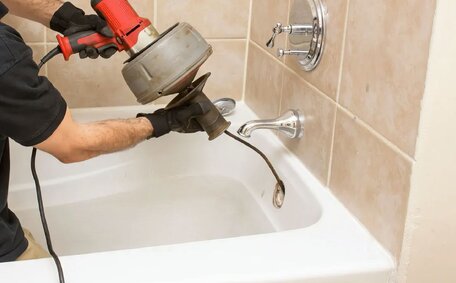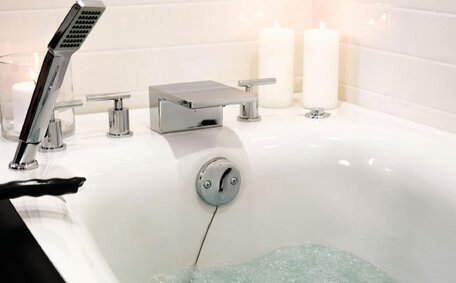What is pipe relining and how does it work?
Pipe relining solutions are crafted to augment your plumbing by rehabilitating your existing pipe with trenchless technology, thus creating a new pipe within an old one, perfectly suited for multifaceted systems without the need extensive excavation. This trenchless method utilises durable epoxy resins that need no excavation to repair and form a new, jointless lining inside the host pipe.
The one day process of relining pipe begins with an inspection using CCTV cameras to assess the location and extent of damage from broken pipes, ensuring the new pipe within old one perfectly aligns. Measurements are taken to ensure the correct size relining materials are used. The existing pipe is then cleaned and prepared.
A flexible sleeve or tube made of epoxy resin is fed into the plumbing pipe and inflated, forming a new inner pipe within the old one as it moulds to the shape of the interior walls. It is usually cured using hot water, steam or UV light. Once set, the new lining undertakes effective drain repair by providing a smooth, seamless inner surface inside old pipes, resulting in a structurally sound new 'pipe within an old pipe’.
Relining can be applied to all types of drain pipes, including those more susceptible to tree root intrusions, ranging from 32mm to those leading to your water tank, up to 2500mm in diameter. Pipe relining solutions cause minimal disturbance, ensuring your pipes can be rehabilitated much faster than with traditional replacement methods.
Key benefits of using pipe relining in heritage buildings
Pipe relining offers key advantages for your home and we know how it would highly benefit landscapes, especially in heritage buildings where preserving architectural integrity is paramount:
- Minimally invasive - Unlike traditional methods that may damage your property, relining requires little excavation, causing minimal disturbance to the structure.
- Preserves aesthetics - There is no need cut into walls or floors, protecting decorative features.
- Longevity - The seamless epoxy resin lining offers long term prevention of deterioration, extending the life of underground pipes in the plumbing system.
- Efficiency - The installation process, often quicker than traditional drain cleaning, results in significantly less downtime.
- Cost-effective - Relining eliminates the high expense of restoration work after major pipe repairs.
- Sustainable - Relining is an environmentally friendly method that preserves existing materials, reducing landfill waste.
The durability and longevity of your pipe system enhanced by pipe patching and relining methods, combined with their non-destructive nature, makes them ideal for heritage buildings.
Considerations when using pipe relining in heritage structures
When using pipe relining in heritage structures, there are several important considerations that must be evaluated:
Historical significance
What pipe types, historical value and original features of the building need to be thoroughly assessed before undertaking any repairs. Heritage consultants may be required to determine if it does pipe relining or another method to preserve integrity.
Condition of pipes
Inspections should diagnose the location and severity within a damaged drain, particularly from tree roots requiring sewer pipe repair due to aggressive growth. If structural issues exist, engineers may need to sign off on relining instead of full replacement.
Regulations
Local council approvals often apply to repairs on heritage buildings. Plumbers must comply with regulations about protecting original materials and working on sensitive sewer line repairs with care.
Access issues
If pipe access is difficult, modifications to relining equipment or custom fabrication may be necessary when working around restricted spaces or decorative features.
With meticulous planning and consultation, pipe relining work can successfully repair a damaged pipe in heritage buildings while preserving their heritage value. Assessments are key to tailoring an approach that maintains aesthetics and structural integrity.
How pipe relining preserves heritage buildings
As most pipe relining work is concise and minimally disruptive, it is an ideal plumbing repair solution for heritage buildings, avoiding the major disruptions of traditional pipe replacement methods. There is no need to dig up ancient flooring, decorative features or structural walls when relining pipes.
The process, which can carried out by seasoned professionals, begins with a CCTV pipe inspection to diagnose areas of damage and determine best access points for relined pipe installation. The flexible epoxy resin lining tube is then fed through the existing pipe and inflated to form a tight seal against the interior walls. No excavation around the heritage building is required.
The jointless, seamless lining is more efficient than pipe cleaning solutions, resolving issues such as blocked drains, creating a 'pipe within a pipe’ while preserving heritage materials. Relined pipes are extremely durable and prevent further deterioration of the plumbing system. Using trenchless technology, the non-destructive approach maintains architectural integrity.
Advancements in pipe relining allow for preservation of heritage buildings where retaining historical significance is paramount. The meticulous, non-invasive nature of the technique causes minimal impact to these structures.
Recent advancements making pipe relining suitable for heritage buildings
There have been several key advancements in pipe relining technology that now make it an excellent plumbing repair solution for heritage buildings:
- Improved type material formulas allow linings to negotiate complex bends and transitions within heritage sewer pipes systems.
- Curing methods like UV and steam enhance resin strength for optimal structural integrity.
- Better CCTV cameras provide detailed inspections to minimise invasive access points.
- Specialised fabrication of liners ensures conformance to irregular heritage pipe dimensions.
- Low-emission epoxy resins reduce odours and contamination during installation.
With custom solutions now available, pipe relining presents a tailored relining solution for your heritage property’s needs, sensitively repairing leaks and corrosion while avoiding surrounding structural damage.
The durability added by the seamless epoxy lining from the relining process also prevents future issues, extending the lifespan of old pipes and preserving buildings for generations.
Common questions about using pipe relining in heritage buildings
Here are answers to some common questions about using pipe relining in heritage buildings:
Is pipe relining structurally sound?
Yes, relining can used to add longevity to existing plumbing systems without replacing pipes when you need pipe repair. The seamless epoxy resin bonds securely to form a structurally reinforced 'pipe within a pipe’.
How long do relined pipes last?
Properly installed, pipe relining can effectively address a blocked drain and comes with a year guarantee, often extending to 50 years or more, enhancing your drainage system’s longevity and efficiency. The epoxy lining prevents further corrosion and deterioration, extending the lifecycle of heritage plumbing.
Can complex pipe layouts be relined?
Modern pipe relining is highly versatile and can also negotiate bends, transitions, and multi-dimensional changes within heritage plumbing networks, all thanks to the new lining material and advanced installation equipment.
Does relining work for large pipe sizes?
Yes, advanced techniques can be utilised for relining, scaling up large diameter pipes to 2500mm. The resin cures evenly regardless of size. Access points are customised to diameter during on-site installation.
To learn more about the impact of recent innovations, have our experts come out and explain how pipe relining provides effective and minimally invasive solutions for complex heritage plumbing structures, including cast iron pipes, where preservation is paramount.
Why pipe relining should be considered for heritage buildings
Determining if pipe relining worth the investment is crucial as it offers a minimally invasive solution for damaged pipes, uniquely suited to preserving the integrity of your property, particularly heritage buildings. By inserting a durable epoxy resin lining that can be used to repair failing pipes, there’s no need for major excavation, so trenchless pipe lining avoids significant work that could damage historic features.
Relining, a form of trenchless pipe repair technology, can help create a structurally reinforced 'pipe within a pipe’, offering to rehabilitate old plumbing networks without the need dig up your landscape, preventing further deterioration and leakage and adding decades of longevity. The seamless lining handles complex layouts with bends, transitions and multi-dimensional changes in direction.
Advanced CCTV pipe inspections, which we use for precise diagnosis of root intrusion and other issues, together with enhanced resin formulas and curing methods, permit meticulous placement of relined pipes inside heritage edifices.
With custom fabrication meeting non-standard dimensions, and expert plumbers adept at fixing leaks blockages sensitively under heritage regulations, pipe relining enables in-situ repairs to preserve architectural aesthetics and integrity for generations.
Finding qualified professionals for heritage building plumbing projects
Finding skilled tradespeople for pipe relining services that ensure your heritage buildings are undamaged requires careful vetting for appropriate expertise. When sourcing professionals, consider the following:
Experience with heritage sites
Look for proven experience working sensitively on buildings with heritage status. Check for familiarity with regulations, restoration processes and adaptive methodologies.
Local area competency
We highly recommend his team for plumbers with intimate, up-to-date knowledge of local council guidelines related to Marrickville heritage sites.
Certifications
Qualified plumbing services, supported by a team were exceedingly professional, hold appropriate licences and accreditations. Ask for verification of skills and training.
References
Clients were delighted with well-established plumbers who exemplified quality work and provided referees and testimonials demonstrating they’ve done a great job on comparable heritage projects.
For experienced, trusted plumbers in Marrickville, call us at Marrickville Plumbing on 1300 349 338 or email [email protected] to arrange assessments and quotes.
Conclusion - pipe relining, a versatile solution for heritage buildings
Pipe rehabilitation through relining preserves existing pipes excellently, providing a solution your heritage building can depend on. By inserting a seamless epoxy resin lining inside ageing pipes, Pipe relining rehabilitates and reinforces existing plumbing networks to fix your pipes without extensive destruction to irreplaceable historic features.
Advanced pipe relining techniques and materials adapt to complex sewer stormwater layouts while maintaining architectural integrity. With experienced professionals like Marrickville Plumbing undertaking assessments and installation, property owners can efficiently resolve leaks and deterioration issues through trenchless pipe relining.
Pipe relining adds decades of longevity compared to traditional replacement methods. The versatility, longevity and non-destructive approach of plumbing pipe relining make it a sustainable investment in safeguarding Australia’s heritage buildings for future generations while retaining their heritage value.
We would highly recommend contacting the specialists at Marrickville Plumbing on 1300 349 338 to find out more about Sydney pipe relining, or arrange an on-site assessment of your heritage property’s plumbing requirements.






